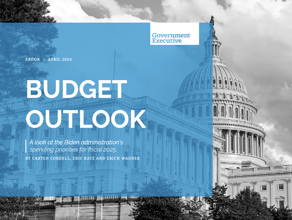DHS bottom-up review is long on ambition, short on detail
Lawmakers expected a roadmap for improving management and efficiency.
The Homeland Security Department's months-long bottom-up review sent to Congress in early July was intended to align the department's programs and organizational structure with key mission priorities expressed in February's Quadrennial Homeland Security Review. But anyone looking for details on how that will occur is likely to be disappointed.
Congress required the two reviews to clarify DHS agencies' roles and missions within the seven-year-old department and better align them with resources.
"The review is disappointingly short on the programmatic and organizational details that would be necessary for it to serve as a roadmap for advancing the goals outlined in the [Quadrennial Homeland Security Review]," Sen. Susan Collins, R-Maine, ranking member of the Senate Homeland Security and Governmental Affairs Committee, said in a statement.
House Homeland Security Committee Chairman Rep. Bennie Thompson, D-Miss., had an even harsher assessment. "While the BUR provides more context for how DHS intends to execute its missions, it is not the deep dive that Congress was promised," he said.
"DHS was created so swiftly that not enough thought was given to how best to address the core organizational and management needs of this new agency. As a result, the department's ability to efficiently and effectively execute all its missions has been undermined. This review was a chance to get it right, but, unfortunately, it seems to miss the mark," Thompson said.
Homeland Security's assistant secretary for policy, David Heyman, defended the 70-page review in a briefing with reporters on Friday, noting it was the first comprehensive examination and mapping of all the department's activities. "We have for the first time ever a powerful tool for our leadership team to be able to look at what we're doing in various different views. We can view things through the domain awareness spectrum, we can view things through the preventing terrorism spectrum, or we can view things through an organizational spectrum, like Customs and Border Protection."
The document is organized around six mission areas: preventing terrorism and enhancing security; securing and managing borders; enforcing immigration laws; securing cyberspace; ensuring resilience to disasters; and complementary responsibilities and hybrid capabilities. It also includes sections on improving management and increasing accountability.
Each mission area and section includes a description of initiatives and enhancements aimed at improving performance, or what Heyman characterized as the "meat" of the report. While the initiatives provide insight into DHS' goals, they are frequently too vague or point to things beyond the department's control.
For example, in the section on preventing unlawful immigration, the top initiative is "comprehensive immigration reform." The report says DHS supports legislative reform that, among other things, "crafts a tough but fair program under which illegal immigrants will register, record biometrics, pass a criminal background check, pay any back taxes, pay a fine, learn English, and in return, be allowed to remain legally in the country and earn the opportunity for lawful permanent residence." Leaving aside the political viability of such a program, there's no indication how the department would administer it or enforce its requirements.
The section on improving management cites eight initiatives and enhancements, including realigning the regional structures of seven component agencies to increase efficiencies across the department. But the report makes no mention of the Coast Guard's long-standing request for congressional authorization to reorganize its command structure to better align with its missions and those of other military services. Nor does it mention plans at the Federal Emergency Management Agency to push more authority from headquarters to regional offices. Whether or not DHS supports these efforts, or how they might mesh with a broader regional alignment across the department is unclear.
The initiatives in the review will be fleshed out in the 2012 budget request the department submits to Congress next February, Heyman said.
"We had to balance how much detail we could put in, given that the president's budget has not gone forward. In some places you have a little more grist on the bone. In other places you have a little more of us tipping our cards as to where we're going to go," he said.
NEXT STORY: Pentagon prepares funding contingencies



